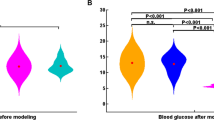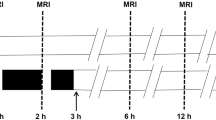Abstract
The early evolution of ischemic brain injury under normoglycemic and streptozotocin-induced hyperglycemic plasma conditions was studied using magnetic resonance imaging (MRI). Male Sprague-Dawley rats were subjected to either permanent middle cerebral artery occlusion (MCAO), or 1-h MCAO followed by reperfusion using the intraluminal suture insertion method. The animals were divided into four groups each with eight rats: normoglycemia with permanent MCAO, normoglycemia with 1-h MCAO, hyperglycemia with permanent MCAO, and hyperglycemia with 1-h MCAO. Diffusion-weighted images (DWIs) and T2-weighted images (T2WIs) were aquired every l h from 20 min until 6 h after MCAO, at which time cerebral plasma volume images (PVIs) were acquired. Tissue infarction was determined by triphenyltetrazolium chloride staining at 7 h after MCAO. The ischemic damage, measured as the area of DWI and T2WI hyperintensity and tissue infarction, increased significantly in hyperglycemic rats in both permanent and transient MCAO models. In the permanent MCAO model, the maximal apparent water diffusion coefficient (ADC) decline under either normoor hyperglycemia was about 40%, but the speed of ADC drop was faster in hyperlgycemic rats than in normoglycemic rats. Reperfusion after l h of MCAO in normoglycemic rats partly reversed the decline in ADC, whereas the low ADC area continued to expand after reperfusion in the hyperlgycemic group. Between the two hyperglycemic groups with either permanent MCAO or reperfusion, no significant difference was found in the infarct volume measured at 7 h after MCAO. However, reperfusion dramatically increased the extent and accelerated the development rate of vasogenic edema. ADC in the hyperglycemic reperfusion group also dropped to a lower level. A large “no-reflow” zone was found in the ischemic hemisphere in the hyperglycemic reperfusion group. This study provides strong evidence to support that preischemic hyperglycemia exacerbates ischemic damage in both transient and permanent MCAO models and demonstrates, using MRI, that reperfusion under preischemic hyperglycemia accelerates the evolution of early ischemic injury.
Similar content being viewed by others
Reference
Ames A, Wright RL, Kowada M, Thurston JM, Majno G (1968) Cerebral ischemia: the no-reflow phenomenon. Am J Pathol 52:437–453
Baker LL, Kucharczyk J, Sevick RJ, Mintorovitch J, Moseley ME (1991) Recent advances in MR imaging/spectroscopy of cerebral ischemia. Am J Roentgenol 156:1133–1143
Baughman VL, Hoffman WE, Miletich D, Albrecht RE, Thomas C (1988) Neurologic outcome in rats following incomplete cerebral ischemia during halothane, isoflurane. or N2O. Anesthesiology 69:192–198
Bederson JB, Pitts LH, Germano SM, Nishimura MC, Davis RL, Bartkowski MB (1986) Evaluation of 2,3,5-triphenyltetrazolium chloride as a stain for detection and quantification of experimental cerebral infarction in rats. Stroke 17:1304–1308
Benveniste H, Hedlund LW, Johnson GA (1992) Mechanism of detection of acute cerebral ischemia in rats by diffusion-weighted magnetic resonance spectroscopy. Stroke 23:746–754
Branch CA, Helpern JA, Ewing JR Welch KM (1991) 19F NMR imaging of cerebral blood flow. Magn Reson Med 20:151–7
Busza AL, Allen KL, King MD, Bruggen N van, Williams SR, Gadian DG (1992) Diffusion-weighted imaging studies of cerebral ischemia in gerbils. Potential relevance to energy failure. Stroke 23:1602–12
Candelise L, Landi G, Orazio EN, Boccardi E (1985) Prognostic significance of hyperglycemia in acute stroke. Arch Neurol 42:661–663
Choi DW (1992) Excitotoxic cell death. J Neurobiol 23:1261–1276
Davis D, Ulatowski J, Eleff S, Lzuta M, Mori S, Shungu D, Zijl PC van (1994) Rapid monitoring of changes in water diffusion coefficients during reversible ischemia in cat and rat brain. Magn Reson Med 31:454–460
Folbergrova J, Memezawa H, Smith ML, Siesjo BK (1992) Focal and perifocal changes in tissue energy state during middle cerebral artery occlusion in normo- and hyperglycemic rats. J Cereb Blood Flow Metab 12:25–33
Ginsberg MD, Welsh FA, Budd WW (1980) Deleterious effect of glucose pretreatment on recovery from diffuse cerebral ischemia in the cat. I. Local cerebral blood flow and glucose utilization. Stroke 11:347–354
Gisselsson L, Smith ML, Siesjo BK (1992) Influence of preischemic hyperglycemia on osmolality and early postischemic edema in the rat brain. J Cereb Blood Flow Metab 12:809–816
Hallenbeck JM, Andrew MD, Dutka MD (1990) Background review and current concepts of reperfusion injury. Arch Neurol 47:1245–1254
Hossmann KA, Fisher M, Bockhorst K Hoehn-Berlage M (1994) NMR imaging of the apparent diffusion coefficient (ADC) for the evaluation of metabolic suppression and recovery after prolonged cerebral ischemia. J Cereb Blood Flow Metab 14:723–731
Kanehisa K, Back T, Hoehn-Berlage M, Hossmann KA (1995) A modified rat model of middle cerebral artery thread occlusion under electrophysiological control for magnetic resonance investigations. Magn Reson Imaging 13:65–71
Kato H, Kogure K, Ohtomo H, Izumiyama M, Tobita M, Matsui S, Yamamoto E, Kohno H, Ikebe Y, Watanabe T (1986) Characterization of experimental ischemic brain edema utilizing proton nuclear magnetic resonance imaging. J Cereb Blood Flow Metab 6:212–222
Kent TA, Quast MJ, Kaplan BJ, Najafi A, Amparo E.G., Gevedon RM, Salinas F, Suttle AD, DiPette DJ, Eisenberg HM (1989) Cerebral blood volume in a rat mode of ischemia by MR imaging at 4.7 T. Am J Neuroradiol 10:335–338
Kent TA, Quast MJ, Kaplan BJ, Lifsey RS, Eisenberg HM (1990) Assessment of a superparamagnetic iron oxide (AMI-25) as a brain contrast agent. Magn Reson Med 13:434–443
Knight RA, Ordidge RJ, Helpern JA, Chopp M, Rodolosi LC, Peck D (1991) Temporal evolution of ischemic damage in rat brain measured by proton nuclear magnetic resonance imaging. Stroke 22:802–808
LeBihan D, Turner R (1991) Intravoxel motion imaging using spin echoes. Magn Reson Med 19:221–227
LeBihan D, Breton E, Lallemand D, Grenier P, Cabanis E, Lavaljeantet M (1986) MR imaging of intravoxel incoherent motions: application to diffusion and perfusion in neurologic disorders. Radiology 161:401–407
Longa EZ, Weinstein PR, Carlson S, Cummins R (1989) Reversible middle cerebral artery occlusion without craniectomy in rats. Stroke 20:84–91
Memezawa H, Minamisawa H, Smith ML, Siesjo BK (1992) Ischemic penumbra in a model of reversible middle cerebral artery occlusion in the rat. Exp Brain Res 89:67–78
Moseley M E, Cohen Y, Mintorovitch J, Chileuitt L, Shimizu H, Kucharczyk J, Wendland MF, Weinstein PR (1990) Early detection of regional cerebral ischemia in cats: comparison of diffusion- and T2-weighted MRI and spectroscopy. Magn Reson Med 14:330–346
Moseley M, Crespigny AJ de, Roberts TP, Kozniewska E, Kucharczyk J (1993) Early detection of regional cerebral ischemia using high-speed MRI. Stroke 24:160–165
Nagasawa H, Kogure K (1989) Correlation between cerebral blood flow and histologic changes in a new rat model of middle cerebral artery occlusion. Stroke 20:1037–1043
Paxinos G, Watson C (1986) The rat brain in stereotaxic coordinates, 2nd edn. Academic, Sidney
Perez-Trepichio AD, Xue M, Ng TC, Majors AW, Furlan AJ, Awad IA, Jones SC (1995) Sensitivity of magnetic resonance, diffusion-weighted imaging and regional relationship between the apparent diffusion coefficient and cerebral blood flow in rat focal cerebral ischemia. Stroke 26:667–675
Pulsinelli WA, Waldman S, Rawlinson D, Plum F (1982) Moderate hyperglycemia augments ischemic brain damage: a neuropathologic study in the rat. Neurology 32:1239–1246
Pulsinelli WA, Levy DE, Sigsbee B, Scherer P, Plum F (1983) Increased damage after ischemic stroke in patients with hyperglycemia with or without established diabetes mellitus. Am J Med 74:540–544
Quast MJ, Huang NC, Hillman GR, Kent TA (1993) The evolution of acute stroke recorded by multimodal magnetic resonance imaging. Magn Reson Imaging 11:465–471
Quast MJ, Wei J, Huang NC (1995) Nitric oxide synthase inhibitor NG-nitro-l-arginine methyl ester decreases ischemic damage in reversible focal cerebral ischemia in hyperglycemic rats. Brain Res 677:205–212
Riddle MC, Hart J (1982) Hyperglycemia, recognized and unrecognized, as a risk factor for stroke and transient ischemic attacks. Stroke 13:356–359
Siesjo BK (1992a) Pathophysiology and treatment of focal cerebral ischemia. Part I: pathophysiology. J Neurosurg 77:169–184
Siesjo BK (1992b) Pathophysiology and treatment of focal cerebral ischemia. Part II: mechanisms of damage and treatment. J Neurosurg 77:337–354
Siesjo BK, Katsura K, Mellergard P, Ekhholm A, Lundgren J, Smith ML (1993) Acidosis-related brain damage. Prog Brain Res 96:23
Siesjo BK (1988) Acidosis and ischemic brain damage. Neurochem Pathol 9:31–88
Stejskal EO, Tanner JE (1965) Spin diffusion measurements: spin echoes in the presence of a time-dependent field gradient. J Chem Phys 42:288–292
Warner DS, Smith ML, Siesjo BK (1987) Ischemia in normo- and hyperglycemic rats: effects on brain water and electrolytes. Stroke 18:464–471
Weisfeldt ML (1987) Reperfusion and reperfusion injury. Clin Res 35:13–20
Williams DS, Detre JA, Leigh JS, Koretsky AP (1992) Magnetic resonance imaging of perfusion using spin inversion of arterial water. Proc Natl Acad Sci USA 89:212–216
Winocore PD (1994) Platelets, vascular disease, and diabetes mellitus. Can J Physiol Pharmacol 72:295–303
Zoppo GJ del, Schemid-Schonbein GW, Mori E, Copeland BR, Chang CM (1991) Polymorphonuclear leukocytes occlude capillaries following MCA occlusion and reperfusion in baboons. Stroke 22:1276–1283
Author information
Authors and Affiliations
Rights and permissions
About this article
Cite this article
Huang, N.C., Wei, J. & Quast, M.J. A comparison of the early development of ischemic brain damage in normoglycemic and hyperglycemic rats using magnetic resonance imaging. Exp Brain Res 109, 33–42 (1996). https://doi.org/10.1007/BF00228624
Received:
Accepted:
Issue Date:
DOI: https://doi.org/10.1007/BF00228624




